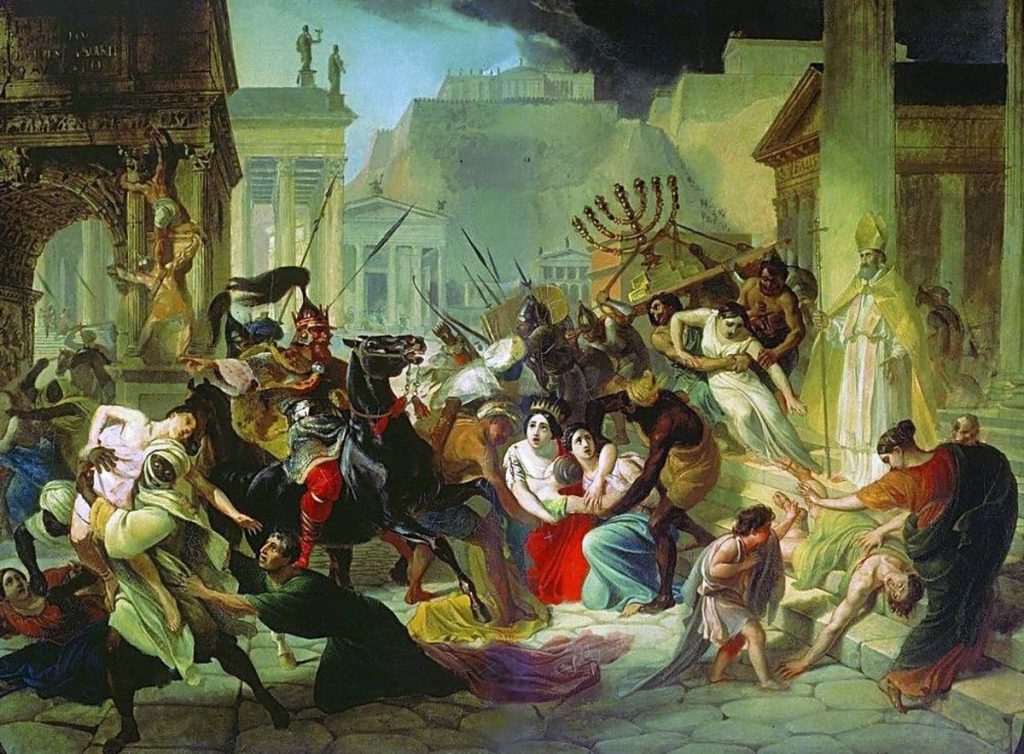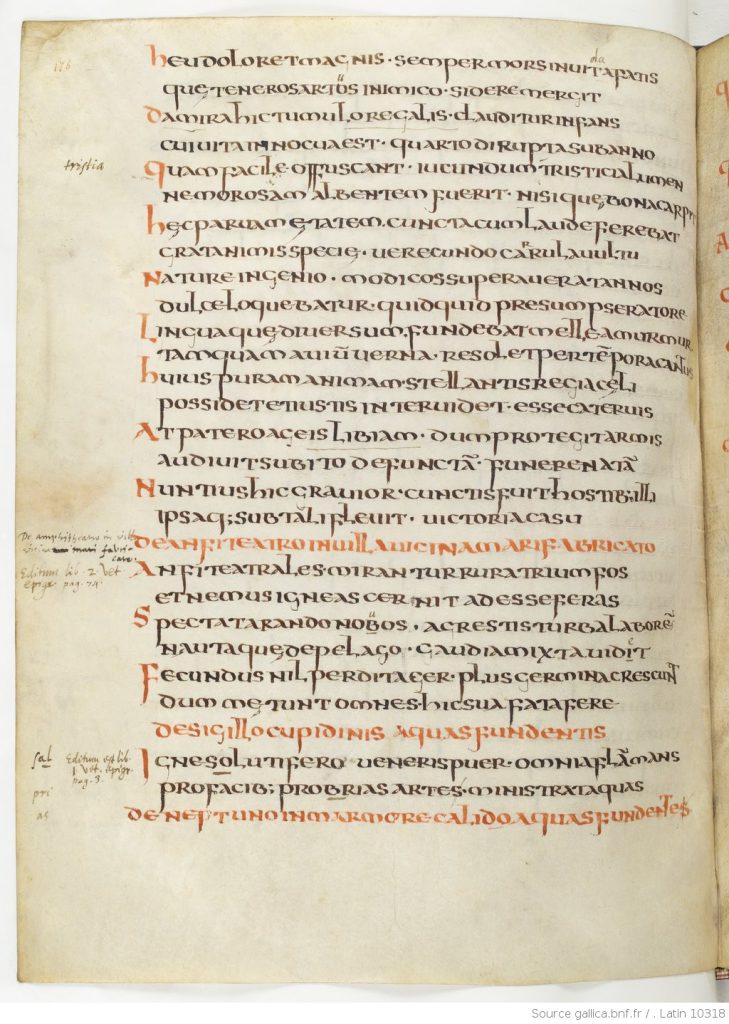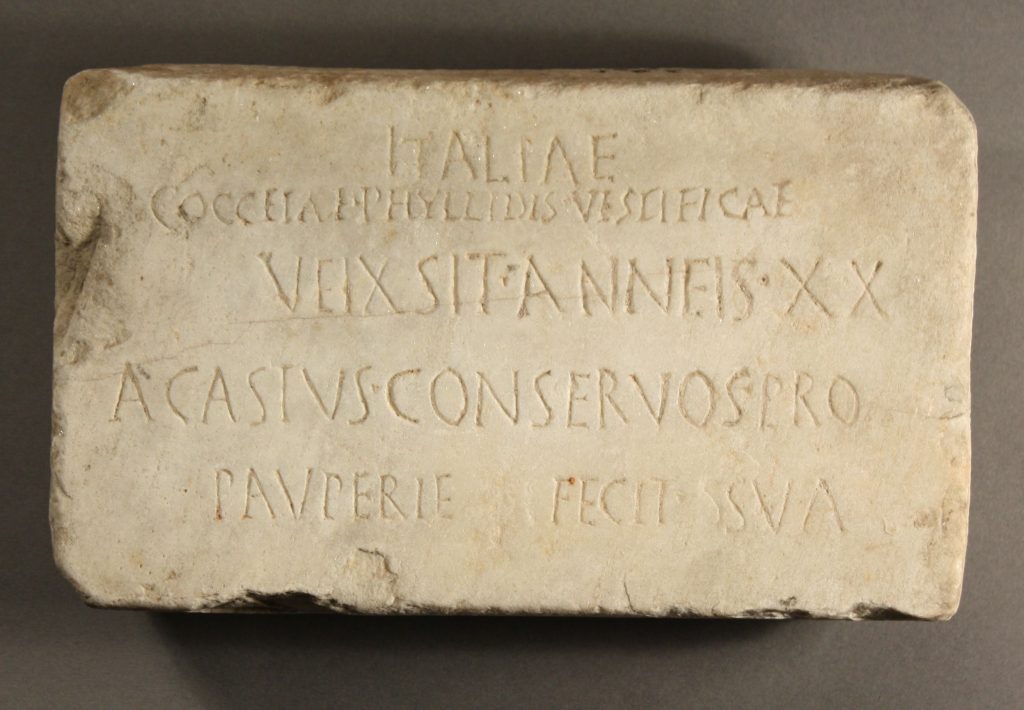Luxurius stands at a turning point of Roman history in Africa: The historical references in his epigrammata point to the very end of the Vandal kingdom and thus to the end of Roman culture, which with Luxurius loses its last poet on African soil.
The violent rise of king Geiserich is certainly the most famous phase of the hundred-year history of the Vandal Empire: He had laid its foundations in the Western Mediterranean by transferring his forces and the whole entourage in AD 428 from Spain to Africa; about ten years later he captured Carthage and in 455 confirmed his claim to power in the western hemisphere with a drumbeat: With the sacking of Rome by his barbarian hordes.

For mutual reasons, the military conflicts with Western and Eastern Rome then remained a constant companion to the formation and consolidation of the Vandal dominion. And the threat from the Berbers at the southern border as well as in the highlands did not calm the kings from Geiserich to Gelimer (AD 428-534) either. In addition, the former province of Africa proconsularis was shaken by internal turmoil of religious fundamentalists. The conflicts of the 5th and 6th centuries between Vandal Arians and Roman Catholics, the activities of the Donatists and the so-called circumcelliones (Augustinus) in Northern Africa have shaped a picture of the Vandal period that bears witness to a deep social insecurity of broad population strata in this rich and fertile country, which has always been considered the ‘granary of Rome’.
And yet there existed also a totally different world alongside: an independent culture had developed around the sparse ruling class of Vandals and their provincial Roman functionaries, and Roman living and culture was preserved and even developed in the upper circles of Carthage. Procopius of Caesarea (Maritima), a contemporary witness and close confidant of the Eastern Roman general Belisarius, retrospectively castigates the effeminacy of the Vandals, and thus gives us an insight into life and living in Africa Romana at that time:
Warm baths, sumptuous banquets and luxurious clothing, entertainment at theatre performances and horse races, hunting, music and drama determined their everyday lives; in magnificent villas they indulged in drinking and sexual debauchery (Procop., Bell. Vand. 2,6,6) – in Vandal Carthage one could obviously live quite well – just as in Martial’s Rome.
Procopius’s portrayal of the state of affairs at the Vandal court is almost confirmed by Luxurius’s contemporary poetry and the themes conveyed by his approximately 90 epigrams – however, the motivation to choose these subjects for his poems may have been different. Especially in the scoptic epigrams (satire verses) we see a clear match with the sociocritical remarks of Procopius. But we also witness the Roman way of life in the epideictic epigrams: objects such as amphitheatres, gardens, baths represent the space for the social life described in the scoptic poems. The image of a manifold city life full of amusement and debaucheries is ever-present – a dance on the volcano.
For our rather tedious question, which is devoted to the extent to which the poems of Luxurius can be set alongside genuinely inscribed texts, and should perhaps even be regarded as epigraphic evidence, we will draw on these epideictic epigrams. With their focus on real objects, they are from the outset very close to epigraphy. For an epigraphic text is, as we know, inconceivable without a monument. And of course also the two epitaphs (AL 345 and 354 R.), which have been preserved in Luxurius’s liber epigrammaton, show a clear reference to epigraphic tradition.
This late flourishing of Latin poetry, written by the still young poet under Hilderich (AD 523-530) and edited immediately after the last king Gelimer (AD 530-534) by a befriended grammarian named Faustus, is at the same time the chronologically last one in the anthology, which became known under the name ‘Anthologia Latina’. With the liber of Luxurius we also have a chronological reference point for the formation of the anthology as an edition of various small poems in the middle of the sixth century (Happ I 118f.), so that Shackleton-Bailey can summarize the question of chronology as follows: “Satis autem constat in Africa non ita multo post regni Vandalici finem (A.D. 354) poematiorum syllogam institutam fuisse” (ed. p. IV).
A fortunate coincidence of tradition has preserved these epigrams of Luxurius, together with the other poems of the Anthologia Latina. In an early manuscript from the 8th century, quite soon after the constitution of the antique edition (middle of the 6th century), the Codex Salmasianus (Paris. Lat. 10318) was conceived, the main witness for Luxurius: barely 200 years after the antique original.
Damira’s epitaph (AL 345 R.) is of particular interest with regard to the genre question and the relationship of the poem to epigraphy: The ‘presence’ of the poet at the tomb brings into focus the question of the epigraphic character of the epigram, as it is readily assumed in scholarship that many of his poems were indeed carved in stone. After a general complaint about fate (v. 1-2) the poem turns to the person Damira – and this in typical epigraphic diction – with the deictic hic as well as the the naming and the age of the dead, both necessary elements of a grave inscription: Damira hic tumulo regalis clauditur infans | cui vita innocua est quarto dirupta sub anno (v. 3-4). A very general, almost inappropriate thematization of mors immatura interrupts the individual lament for the dead; and only then follows a renewed turn to the deceased, which makes a haec (v. 7) necessary.
For a real grave inscription of a royal person in Vandalic times we would expect more: a (prose) prescript that at least mentions the name of the person concerned in relation to her father Oageis/Euagees – a famous army commander and “Wandalenprinz” (Happ II 341), who can be determined from the later narrative addition (v. 15-18). But certainly his name would not appear on the inscription in the banal form of pater Oageis (v. 15). In addition to the indication of age, we would also expect the depositio, which is regularly noted in this period. And one misses a clear Christian commitment:
Damira’s pure soul has found home after her early death in the kingdom of the starry heaven: puram animam stellantis regia caeli | possidet (v. 13f.) – however, this hexameter closure is not a general poetic formula, but a direct borrowing from Vergil (Verg. Aen. 7, 210: nunc solio stellantis regia caeli / accipit) and thus to be explained by literary imitation. If we want to reconstruct a Christian background from this choice of words or even see a “sentiment tout chrétien” (P. Monceaux 277), this could only be obtained in distinction to Vergil. But the verse remains committed to pagan ideas – the dualism of body and soul post mortem is quite familiar to antiquity long before Christianity. And this is fully in line with Luxurius’s overall attitude in his epigrams – his world is that of Graeco-Roman mythology.
The poem at hand could at best have been an inscription, which later has been adapted in form for the literary collection. Both the general complaint (v. 1-2; 5-6) and the narrative addition post depositionem at the end (v. 15-18) indicate this. For one thing is clear: despite the deictic hic tumulo … tegitur (v. 3), the sepulchral poem is not an epigraphic text, as little as Martial’s Liber spectaculorum with its hic ubi… (II 1.5.7: hic ubi miramur) was carved in stone.

And this is the decisive point: the liber epigrammaton of Luxurius is a literary collection of epigrams written for various occasions (AL 287 R., v. 6: ex variis locis deductos). Those who believe they can prove single poems of this self-contained corpus to be epigraphic ignore the fact that clearly recognizable characteristics of the literary version oppose this. For example, in the second epitaph for a certain Olympius (AL 354 R.) neither the age nor the name of the deceased is mentioned; only a reference in the title to the preceding epigram individualizes this epitaphion supra scripti Olympii . By declaring the poems as epigraphic texts one misses the chance to track down the possible adaptation of inscriptions to literary form; that is, one misses the opportunity to get to know the poet’s technique.
More frequently than sepulchral epigrams, – only these two of Luxurius are handed down – are the descriptions of works of art, fountains, amphitheatres, gardens or other locations, – objects that are particularly suitable for linking with the text of an inscription. In general, P. Monceaux takes it for granted that all ecphrastic poems by Luxurius, which the codex Salmasianus has to offer, were really epigraphically executed and, in his opinion, must have been located above the entrance to the object described in each case.
This also happened in the case of an amphitheatre built on a country estate near the sea (de amphitheatro in villa vicina mari fabricato): Of course, this is not the grand amphitheatre of Carthage from the early imperial era; rather, a natural terrain on a rural estate – maybe framed by a wooden construction – that once offered space for animal hunting; thus no raging mass as in the Roman amphitheatre of a Calpurnius Siculus, but the country itself and the countrymen are the witnesses of the spectacula (mirantur rura – nemus cernit – spectat agrestis turba – nautaque de pelago … videt): a private complex with random spectators. The arena does not even seem to have been a sanded place, for the soil on which the ‘animals fear their fate’ is described as more fertile than ever (v. 5 f.).
Such an ‘inscription’, that doesn’t even mention the owner of the amphitheatre, that doesn’t praise the complex either, but rather describes an almost bucolic scene with random spectators, is only conceivable as a literary game. It thus completely fulfills its purpose in the liber epigrammaton – the literary collection of Luxurius.
Short Bibliography:
Clover, F. M., The Symbiosis of Romans and Vandals in Africa, in: Das Reich und die Barbaren, ed. E. K. Chryss – A. Schwarcz, Wien – Köln 1989, 57-73.
Happ, H., Luxurius I. Text und Untersuchungen, II. Kommentar, Stuttgart 1986.
Monceaux, P., Enquète sur l’épigraphie chrétienne d’Afrique. Inscriptions métriques, RA 7, 1906, 177-192. 260-279. 461-475; RA 8, 1906, 126-142. 297-310.
Schröder, B.-J., Titel und Text. Zur Entwicklung lateinischer Gedichtüber-schriften, Berlin – New York 1999, 212-219. 293-296.
Shackleton-Bailey, D. R., Anthologia Latina I. 1, Libri Salmasiani aliorumque carmina, Stuttgart 1982.
Wolff, É., Deux épitaphes de Luxorius (Anth. Lat. 345 et 354 R = 340 et 349 ShB), no. 49 et 50, in: Vie, mort et poésie dans l’Afrique romain d’après un choix de Carmina Latina Epigraphica, ed. Chr. Hamdoune, Bruxelles 2011, 299-305.

